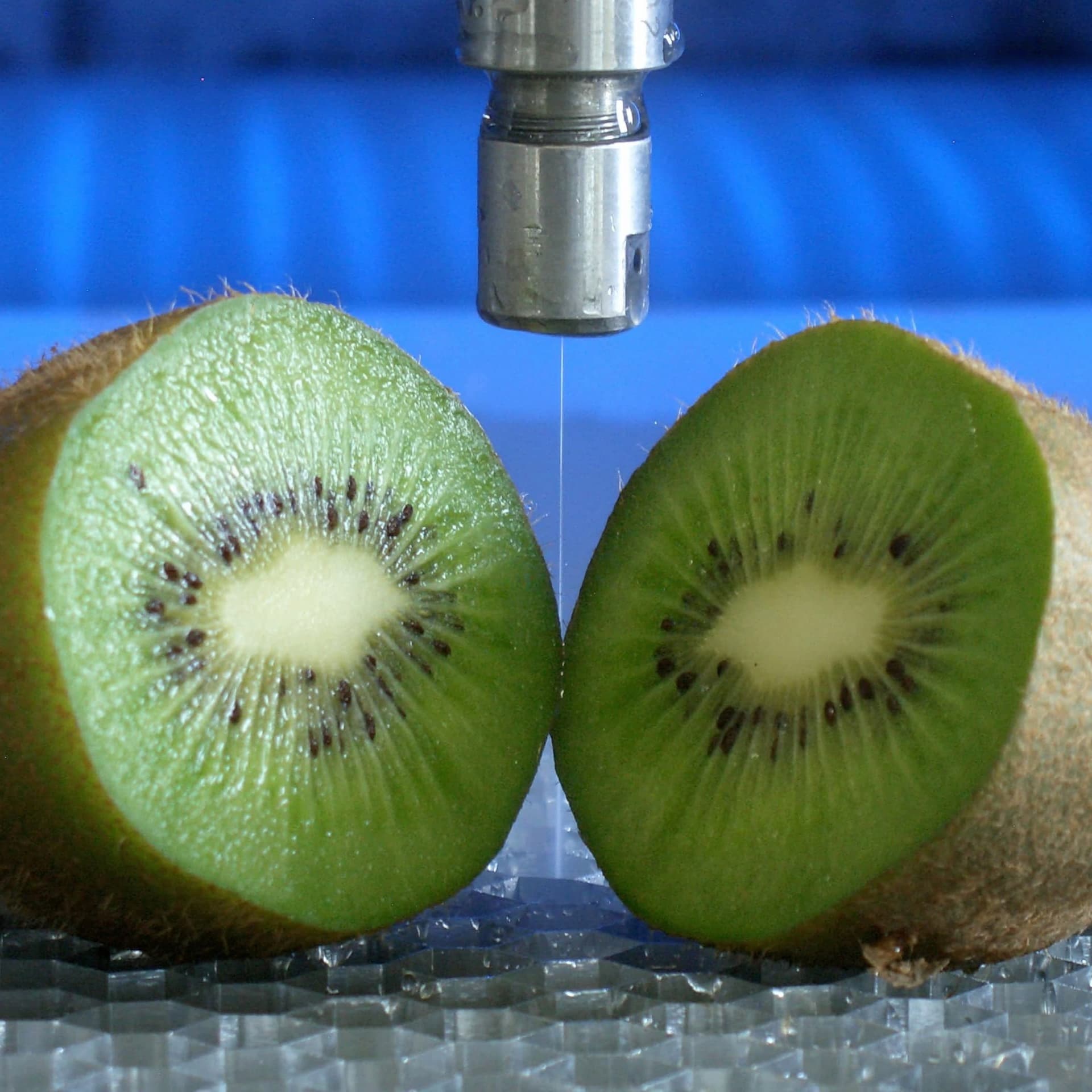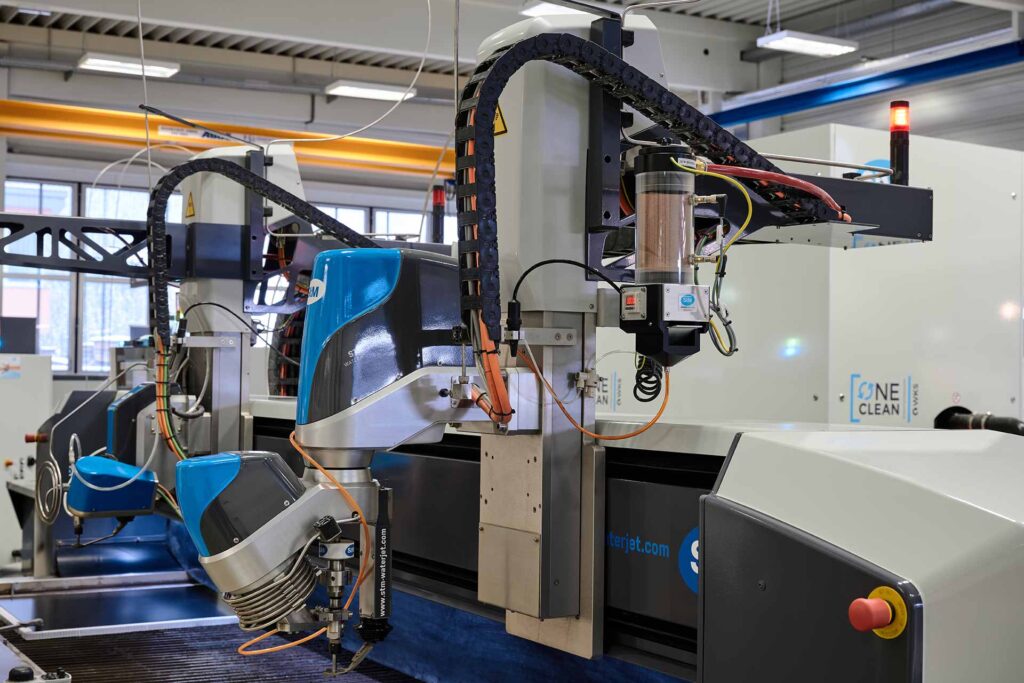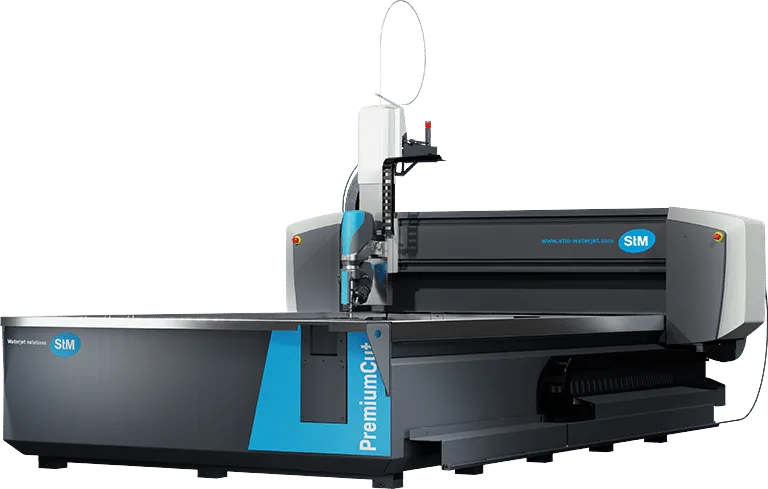Waterjet cutting food
Bread, baked goods, meat, fish, vegetables, fruit, cheese and much more.
Waterjet cutting of food is a highly precise and versatile technique that allows complex shapes and fine cuts to be made in food without damaging it. The technique is applied to a wide range of foods, from soft bread to hard vegetables. In the food industry, waterjet cutting has become a popular method for achieving precise cuts and maximizing product yields. Waterjet cutting opens up new opportunities for the food industry by enabling innovative designs and cutting patterns that can result in more attractive products, which is particularly beneficial in the area of food presentation and packaging.
Waterjet cutting of food offers several important advantages over other cutting methods. It avoids the thermal impact on the food as no heat is generated, thus better preserving nutrients, flavor and texture. The precision of the water jet makes it possible to minimize losses and ensure accuracy when cutting complex shapes. As the cutting process takes place without direct contact, a high level of hygiene is also guaranteed, which is of great importance in the food industry.
The water jet settings can be adjusted to the specific requirements of each food product, allowing high flexibility in processing different products. In addition, food with different density, hardness and texture can be cut without changing the cutting tools. This saves costs and time.
Table of contents
Table of contents
What types of food can be cut?
There is a wide range of food products that can be cut with waterjet cutting. Commonly cut foods include bread and baked goods, such as baguettes, croissants and ciabatta. The precise cutting technique makes it possible to cut these soft and delicate foods without deformation or damage. Meat and fish are also frequently cut with waterjet cutting to obtain precise fillets and steaks. The method ensures that the meat fibers are not damaged and the juice remains in the meat, which is crucial for the quality and taste.
Vegetables and fruits can also be effortlessly processed with waterjet cutting. Tomatoes, onions, peppers and hard vegetables like carrots can be cut precisely without being crushed or deformed. Likewise, the technology enables clean cutting of various types of cheese, confectionery such as chocolate and cakes, as well as nuts and dried fruit. The precise cuts allow aesthetically pleasing food presentations to be created and product quality to be enhanced. Overall, waterjet cutting offers a flexible and gentle method to optimize the shape and quality of a wide variety of food products.
Thanks to its precision and gentle on materials, waterjet cutting is the preferred method for processing foams in a wide range of industries.
- Bread and pastries
- Pasta
- Meat and fish
- Vegetables and fruit
- Salads
- Cheese
- Confectionery
- Nuts and dried fruits
- Fresh herbs
- Sushi
Want more information on cutting food with water?
5 advantages – waterjet cutting food
Waterjet cutting of food products offers a variety of advantages. Thanks to its precision, it allows the creation of complex shapes and fine cuts in food without deforming or damaging it. The method does not generate heat, which is especially important to preserve the quality, nutrients and flavor characteristics of delicate foods.
From soft breads and cakes to hard nuts and root vegetables, waterjet cutting can process a wide range of foods accurately and efficiently. The technology offers a hygienic cutting solution as the cutting process takes place without direct contact with the food, minimizing contamination. In addition, precise cutting reduces product loss and waste, resulting in greater efficiency and economy in food processing.
The cutting heads and nozzles used are made of food-grade materials to ensure that no undesirable substances get into the food. The cutting medium, usually water, is natural and non-toxic. No additional lubricant or oil is needed, which ensures food purity. In addition, waterjet cutting enables the cutting of multiple layers of food at the same time, which increases productivity. Overall, waterjet cutting helps to produce high-quality, hygienic and aesthetically pleasing food products.
Technical details
Waterjet cutting of food products is based on the use of a high-pressure water jet that is directed through a special nozzle. The water jet is directed at the food to be cut at very high speed, creating a precise cutting effect. The intensity of the water jet can be adjusted according to food type and density to achieve the optimum cutting quality.
In some cases, waterjet cutting in the food industry also uses abrasive materials, such as fine particles of abrasive, to increase cutting performance.
The technical details of waterjet cutting allow high flexibility in the design of cuts and patterns in food products. With the help of computer-controlled cutting heads, the shape of the water jet can be precisely controlled, which makes it possible to realize complex shapes and cuts. In the food industry, the precise cutting capabilities offer innovative design possibilities for packaging, presentation and the development of new food products.
As a rule, soft and delicate foods, such as bread, cakes or fruit, can be cut in very thin layers, often in the range of a tenth of a millimeter. This precision allows for a fine and clean cut edge without crushing or deforming the food.
With the addition of abrasives, the waterjet can intensify its cutting action and reach material thicknesses of several centimeters.
Any shape cuts and bevel cuts up to 60° are possible.
The cutting accuracy is usually +/- 0.1 mm.
In waterjet cutting, the cut quality is basically divided into 5 quality levels.
- Separating cut Q1 (for blanks / semi-finished products)
- Standard cut Q3 (the most common cut)
- Fine cut Q5 (for optimum dimensional accuracy)
For waterjet cutting of food, the achievable cutting speeds are usually between 1000 and 6000 mm per minute.
As a rule, the water pressure for cutting food is between 2000 and 4000 bar.
CNC control enables precise and repeatable cutting. The STM SmartCut cutting software offers high ease of use and functionality as well as flexibility.
References
The best advertising is known to be satisfied customers
Among our references you will find customers & partners from various fields. Among them are companies and facilities from the following industries:
- Metal industry
- Stone / Ceramics / Glass
- Plastics / foam industry
- Sealing industry
- Prototype / plant engineering
- Microwaterjet
- Educational Institutions
- Research
- Special materials
STM Product Finder
Find your work system – tailored to you
The individual wishes and requirements of our customers are the measure of all things for us. In order to be able to offer customized solutions for every requirement, we have developed a special product finder.
You tell us what you need to deliver perfect work and we put together the individual components and parts, as well as the associated software perfectly and individually. And if you are unsure, let your work material try our test cut.
FAQ – Frequently asked questions
The most frequently asked questions about waterjet cutting of food products
We have collected some FAQ on the topic, waterjet cutting of food, and answered them succinctly for you.
If your question is not answered, please feel free to contact us directly.
Is waterjet cutting suitable for contact with food?
Yes, waterjet cutting is ideally suited for contact with foodstuffs, as food-compatible materials are used for the cutting heads and nozzles, and the cutting medium is usually pure water.
Can waterjet cutting be used on all foods?
Waterjet cutting can be used on most foods as long as they have some stability and are not too liquid to allow precise cutting.
What are the advantages of waterjet cutting compared to other cutting methods?
Waterjet cutting offers advantages such as no thermal effect, precision, versatility and low product loss, which make it an effective and gentle cutting technique for food products.
Is waterjet cutting of food hygienic?
Since the cutting process takes place without direct contact with the food and no lubricants or oils are required, waterjet cutting ensures high hygiene.
What material thicknesses can be achieved with waterjet cutting?
Waterjet cutting enables the cutting of thin layers in the range of a tenth of a millimeter up to thicker material thicknesses of several centimeters.
Is waterjet cutting of food environmentally friendly?
Yes, waterjet cutting is an environmentally friendly cutting method because it produces no harmful fumes, gases or waste and the water can be recycled.
Can waterjet cutting of food cause allergic reactions?
No, since no dust or abrasives are released, allergic reactions are usually not a concern with waterjet cutting.
What are the operating costs for waterjet cutting of food?
Operating costs depend on frequency of use, specific requirements and material consumption, and are minimized by low product losses.
Is waterjet cutting of food time consuming?
The cutting speed of waterjet cutting is comparatively high, which enables efficient and time-saving processing of food.
Can waterjet cutting contaminate food?
No, as waterjet cutting does not release any foreign substances and leaves no harmful residues, there is no risk of food contamination.


